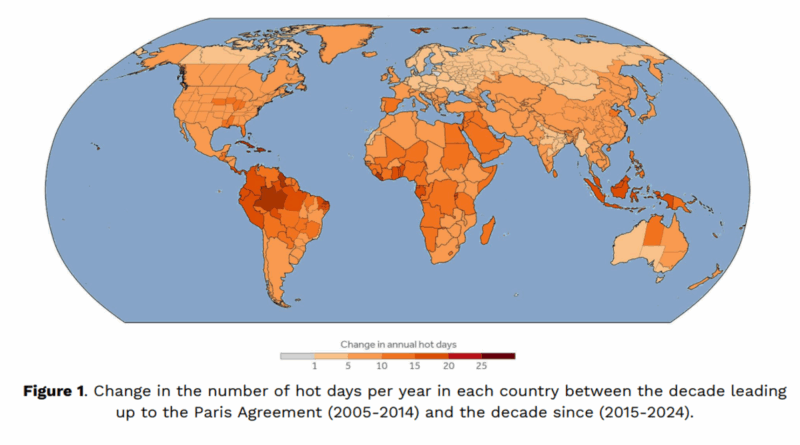Business
Paris Climate Accord Reduces Global Heating to 2.6 Degrees Celsius

Research published by Climate Central and World Weather Attribution indicates that the Paris Climate Accord has effectively limited global heating to an increase of 2.6 degrees Celsius. Without the accord, the global average temperature rise could have reached approximately 4 degrees Celsius. This significant finding highlights the impact of the climate protocols established during the 2015 Paris Agreement, where countries committed to setting their own emissions reduction targets.
The Paris Agreement allowed signatory nations to establish their own frameworks for reducing emissions, known as Nationally Determined Contributions (NDCs). These contributions are intended to be updated regularly to reflect progress. The commitments made in Paris focus not only on climate change mitigation but also on respecting human rights and promoting gender equality.
While the research shows that some reductions in emissions have occurred, a substantial gap remains between current pledges and the necessary cuts to limit global temperature rise to 1.5 degrees Celsius this century. “Moreover, many countries are not on track to meet even their current pledges,” states World Weather Attribution.
The findings from Climate Central suggest that the projected warming has decreased from about 4 degrees Celsius in 2015 to 2.6 degrees Celsius today, assuming that current emissions reduction pledges are fully implemented. However, even a 2.6-degree Celsius rise would lead to significant consequences, including an average increase of 57 extra hot days per year, compared to the current climate conditions. If temperatures rise to 4 degrees Celsius, this could escalate to 114 additional hot days each year.
Recent case studies confirm that extreme heat waves have become more likely since the Paris Agreement was signed. Research indicates that three of the six heat events studied would have been nearly impossible without climate change, with two of those events now about ten times more likely to occur by 2025 than they were in 2015. The report highlights that, despite advancements in heat early warning systems and action plans, insufficient progress and financing for local heat adaptation remain pressing issues.
The consequences of inaction regarding extreme heat are growing, affecting health, labor, and infrastructure. Vulnerable populations are particularly at risk. “There will be pain and suffering because of climate change,” said Kristina Dahl, Vice President for Science at Climate Central and co-author of the report. She emphasized the importance of recognizing the difference between 4 degrees Celsius of warming and 2.6 degrees Celsius, noting that the latter reflects the ambitions set forth over the past decade.
Research also shows that heat waves are increasingly impacting urban areas. The International Institute of Environment and Development reports that the total number of days exceeding 35 degrees Celsius has significantly increased across surveyed cities. In 2024, the total number of such days reached 1,612, a 52 percent increase from 1,058 days in 1994.
The report further details that the heat conditions in southern Europe during the summer of 2023 were 70 percent more likely due to climate change, and future heat waves could be up to 3 degrees Celsius warmer by the end of the century if current climate efforts do not intensify.
The impacts of climate change are disproportionately affecting smaller island nations and developing countries. For example, nations like the Solomon Islands and Panama are expected to face the largest increases in dangerous heat days, even though they contribute minimally to global greenhouse gas emissions. According to the report, Panama could see an increase of 149 extra super-hot days.
The findings illustrate a widening gap between nations responsible for climate change and those bearing its consequences. As highlighted by Andrew Weaver, a climate scientist at the University of Victoria, the impacts of global warming could lead to increased geopolitical instability as developing nations suffer more than those that have historically emitted significant greenhouse gases.
In the United States, states like Florida and Hawaii are projected to experience the largest increases in super-hot days by the century’s end, while states like Idaho will see a smaller rise. The report underscores the urgent need for collective action as the world prepares for discussions at COP 30 in Brazil in November, where nations will address their NDCs and future climate ambitions.
The report serves as a stark reminder of the urgency required to address climate change, with the potential for severe consequences if global temperatures continue to rise unchecked.
-

 Business5 days ago
Business5 days agoUK to Finalize Stablecoin Regulations by 2026, Boosting Crypto Sector
-

 Business5 days ago
Business5 days agoU.S. and U.K. Target Cybercriminal Networks, Seize $15 Billion
-

 Lifestyle5 days ago
Lifestyle5 days agoKISS OF LIFE’s Natty Dazzles in Micro-Shorts at Seoul Event
-

 World4 days ago
World4 days agoMilitary Artillery Plan Sparks Safety Concerns Along California Highway
-

 World5 days ago
World5 days agoTrump Signals Reluctance to Sell Tomahawk Missiles to Ukraine
-

 Business5 days ago
Business5 days agoCalifornia to Eliminate All Plastic Bags from Stores by 2026
-

 Sports5 days ago
Sports5 days agoDomenico Doran’s Stellar Performance Leads Bishop Amat to Victory
-

 Entertainment5 days ago
Entertainment5 days agoLouisiana Senate Raises Concerns Over Medicaid Cuts Amid New Bill
-

 Entertainment5 days ago
Entertainment5 days agoUtah Communities Rally as Government Shutdown Strains Resources
-

 Science2 days ago
Science2 days agoAncient Dinosaur Discovery in Argentina Reveals Evolutionary Insights
-

 Sports5 days ago
Sports5 days agoTrade Low, Trade High: Key NHL Players to Consider Now
-

 Health2 days ago
Health2 days agoUncovering the Hidden Link Between Knee Pain and Hip Issues









